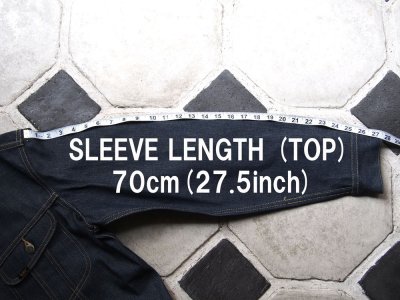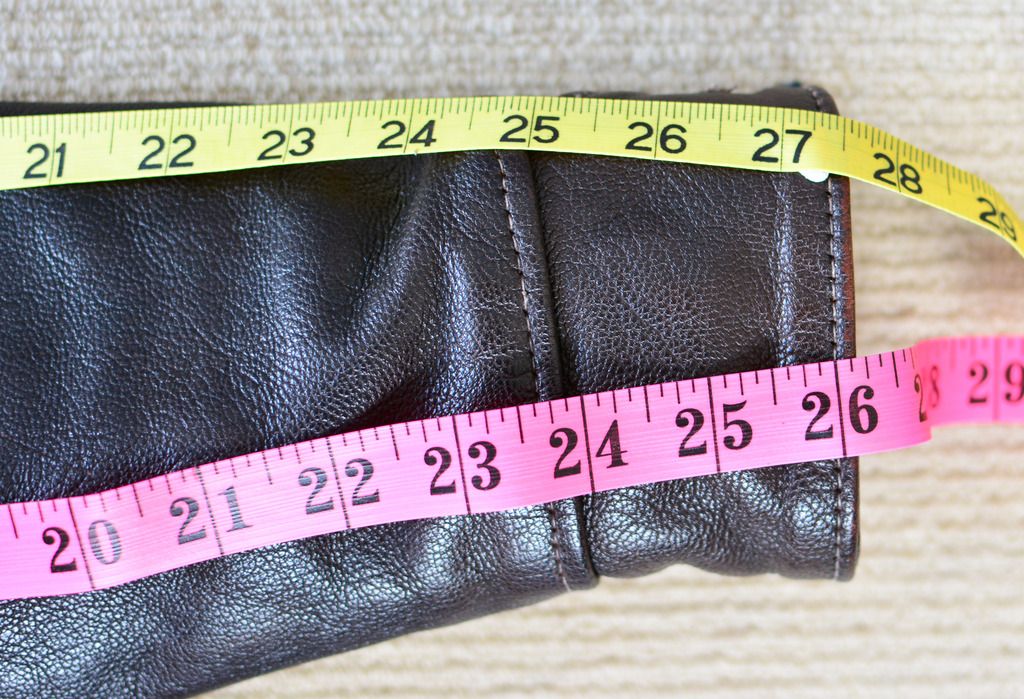I apologize for resurrecting an old thread, but could someone please explain to me what bloody sense does measuring the sleeve like on the photo below makes...
...and why exactly is this wrong?
I mean, if you put a 25" inch pole inside the sleeve of the jacket above, 1" of it would still stick out, any way you go about it, wouldn't it? So how is that sleeve 25" long, exactly?
I think I can explain that. I just hope my explanation won't be even more confusing. Seriously, the sleeve measurement is a bit of a mess, no matter which way you look at it.
The first problem is that unlike the measurements for chest, waist, shoulder and back, the sleeve measurement is not at all a clear-cut thing. It seems to me that the correct way, if you want to be technical, is the method illustrated and described at the HPA site which, incidentally, I think is among the best organized sites:
https://www.historypreservation.com/measuring-jackets
However, most sellers don't use that method. I guess the only solution is to simply measure it one way and specify the method when you provide the measurement. If you know the method, it doesn't really matter which one was used.
The methods are the two you just illustrated, and the HPA one:
1) measuring by following the outer sleeve curvature (your pic #1)
2) measuring in a straight line while leaving the sleeve in its naturally curved position (your pic #2)
3) measuring in a straight line, straightening out the upper part of the sleeve just a little, and sort of extrapolating the sleeve curvature of the lower part of the sleeve (HPA)
Now, what should be our yardstick for sleeve length, anyway? I would say the most reliable yardstick of what sleeve length we really need derives from the shirt sleeve measurement, which is a half arm span measurement (half the shoulder width plus sleeve length). Since shirts have no internal construction, it's easy enough to measure the exact arm span for this type of garment. In order to apply this measurement to jackets, you'll have to add the half measurement of the shoulder width to the sleeve measurement to get the half arm span.
You have to decide how far you want the sleeve to extend beyond the wrist (the point where the skin makes a crease when bending the wrist sideways).
You'll add whatever extra amount to cover the wrist that you're comfortable with. For me, it's zero for suit jackets, 1/4"-1/2" for shirt sleeves and flight jackets (no tunneling for me), and about 3/4" for overcoats and foul weather leather jackets. Add more for motorcycle jackets.
Now, back to the methods of measuring the jacket sleeve.
The equivalent to a shirt sleeve measurement (shirt sleeves straighten easily) and therefore the most reliable would seem to be method #3 (HPA), from experience. It seems that this method neither over- nor underestimates the actually required length.
Method #1 is fine, but it actually overestimates the sleeve length, so if you rely on that measurement and don't know that this method was used, the sleeve may turn out to be shorter than you expected. Why? In theory the sleeve curvature should correspond to the natural curvature of the relaxed arm, but in practice it seems that the jacket sleeve is curved just a little more than the relaxed arm itself (relaxed meaning slightly bent at the elbow).
Method #2 underestimates the sleeve length because both the jacket sleeve and your arms have a natural curvature when held in a relaxed position.
Method #3 is the closest to the shirt sleeve measurement because unlike #2, it doesn't get fooled by the more pronouced curvature towards the end of the sleeve (it's the same on suit jackets and outerwear). This method should yield a measurement somewhere in between #1 and #2.
I think #1 is quite popular and often thought of as the right way of measuring the sleeve because it's the method that tailors use. Technically speaking, it's the most accurate measurement because you can replicate it most accurately, but it doesn't fully correspond to the actually required length as determined by your arm length. It's still possible to mess up that measurement, too, by measuring it on the hanging garment, for instance.
#2 seems to have the advantage that you can't mess it up. Or can you? There's still the issue of where the tape should end, since the sleeve ends at an angle, going by this method. Not really an issue with those tight knit cuffs, but certainly with suit sleeves or leather cuffs.
#3 is probably not very popular because you have to know exactly what you're doing.
Let me know if this was of any help.
Last edited:







